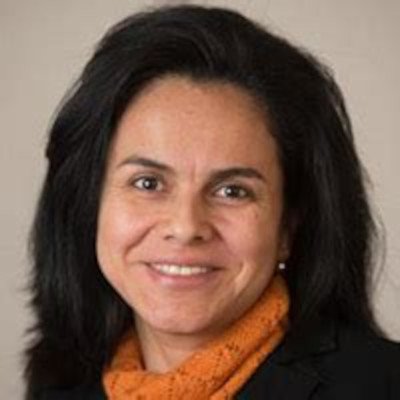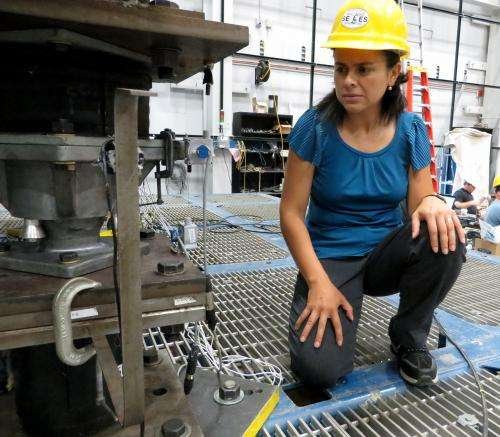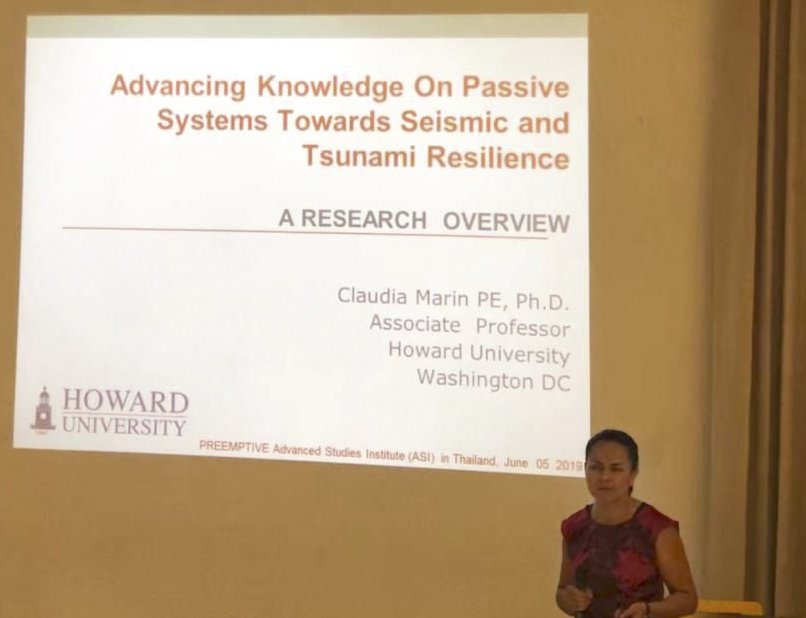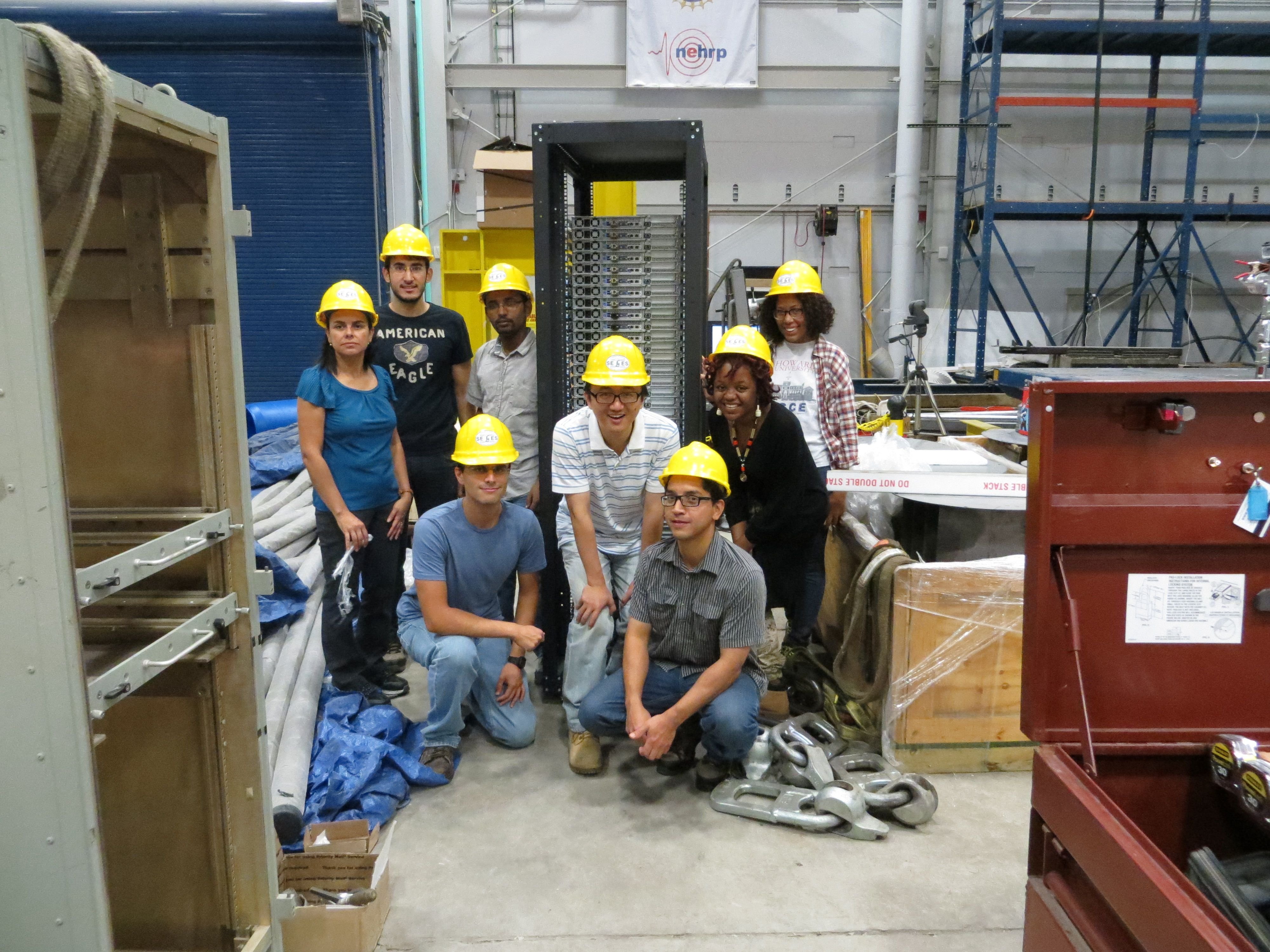NHERI STORIES: DIVERSE PATHS TO ENGINEERING
From Medellín to Washington DC, Claudia Marin blazes a trail in earthquake engineering
Published on March 3, 2023
Claudia Marin, PE
Professor, Department of Civil and Environmental Engineering
Howard University
Washington, DC
My name is Claudia Marin, and I am originally from Medellín, Colombia. I love to solve practical problems to support the engineering community. Beyond academia, my research has received support and interest from industry and the practicing engineering community.

What are your specialties as a researcher? As an educator?
My primary research interests include passive seismic protection, computational mechanics, experimental evaluation of large-scale structural and non-structural components, and structural health monitoring. NSF has sponsored my main research projects, providing funding to support independent, collaborative, multidisciplinary, and convergence research programs.
As an educator, I am committed to supporting students' preparation for the competitive professional market. As an engineer who has practiced for many years and has achieved high levels of responsibility, I understand firsthand the need for disciplined and rigorous training and education in structural engineering to enforce the highest standards of professional integrity.
I teach at Howard University, where I am passionate about conveying to undergraduates the engineers' role in developing multi-hazard resilient mechanisms and AI applications for infrastructure assessment. I always encourage students by explaining how engineers who apply cutting-edge technologies can improve the responses of all structural systems innovatively and effectively to protect human life and property.
How did you first become interested in engineering?
When I was in high school, I was trying to decide between being a veterinarian or an engineer. My dad encouraged me to study civil engineering because he knew civil engineers would always be needed and there were so many different practice areas. When I started the undergraduate program, I discovered my passion for computer programming and, later on, for structural engineering. I took my first programming course learning BASIC (Beginners' All-purpose Symbolic Instruction Code) in the late 80s and understood the power of programming languages. I discovered that if you only program once, the program does everything for you. It seemed so magical to me!
When I was finishing my bachelor's degree, and while in an internship, I was working on the top floor of a government building, and there was a large earthquake; the building began to shake and move from one side to the other; I didn't know what to do; It was scary, I saw a coworker trying to find a window to jump out of. From there, I wanted to learn more about how we can build to make life and buildings safer when earthquakes strike. Years later, I when to graduate school for Earthquake Engineering and computational mechanics degrees.
What was the biggest obstacle you faced? How did you clear that hurdle?
I want to mention an issue that persists and has occurred on several occasions in my professional experience in the United States. It is about the general engineering culture.
As a woman working in structural engineering, the feeling of being on my own is always present. Often, I need to prove to others that my skills, experiences, and ability to contribute are worthwhile. For example, I was invited to a major technical international workshop. I was proud of my presentation and the input and feedback I received after my presentation. Over dinner, the organizer told me, "I'm so glad you were able to participate in the event; I was in dire need to have at least one female presenter; you saved me." Indeed, I was annoyed by what the organizer said; he did not invite me because of my expertise or importance to my research; he asked me to participate just because he needed a female participant. However, I realized that the organizer's comments were irrelevant to me since I met great experts in my technical field. Also, I learned significantly from the audience's feedback in the workshop. My participation in the workshop was meaningful.
So, I have learned to be resilient and persistent. I am going to stick around to demonstrate my potential for meaningful contributions.
What advice do you have for young engineers, especially female engineers, starting on a career similar to yours?
Always be patient and work and prepare as much as its needed to feel confident. Sometimes, people have misconceptions about women in engineering and how they can contribute equally and differently. After interacting with those people, you may find they realize how we can contribute meaningfully. Women significantly contribute to many things and reflect different perspectives. Let's be confident in ourselves and what we can do. If we persist and continually educate ourselves, female engineers can overcome any difficulties associated with biases, and engineering can provide us with meaningful, rewarding experiences.

Howard University professor Claudia Marin is shown with an elastomeric bearing atop a universal hinge. Experimental results indicate that this system may be a good candidate for protecting heavy equipment.

Marin speaks at the PREEMPTIVE Advanced Studies Institute meeting in Thailand, June 2019.

Howard University professor Claudia Marin at the State University of New York at Buffalo earthquake engineering lab with her research team and the "Yahoo frame." With 40 servers installed, the frame was shaken with servers in partial operation to monitor their functionality under earthquake shaking. From left are Marin, Pedro Calado, Amedebrhan Asfaw, Pedro Reshsteiner, Xing Han, Diego Buitrago, Paquilla Jones and Sajeeda Chin.
NHERI stories: Diverse paths to engineering
The roads to engineering are many. In this series, NHERI researchers share their personal and professional stories including insights, obstacles, and advice for future engineers.
Related Links
Smart Structural Health Monitoring (DesignSafe News)
Professor Claudia Marin to Lead NSF Convergence Accelerator Team (Howard CEA News)





